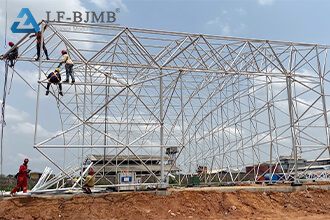+86 177 5193 6871
222, Block B, Diamond International, Guozhuang Road, Xuzhou, Jiangsu, China
In the construction process of large-span steel structure erection, accurate computational simulation is the key to ensuring smooth construction progress. This involves precise prediction of the stress state of the structure, including the effects of gravity, wind load, temperature stress, etc. that the structure is subjected to at different construction stages. Through computational simulation, we can simulate the entire construction process, including the lifting sequence of members, the setting of temporary supports, the treatment of welded joints, etc., to predict the structure’s deformation and stress distribution. Such simulation helps us to discover potential problems in time, optimize the construction plan, and ensure the construction quality and safety.

During the construction process, we also need to pay special attention to the following points:
1. Lifting sequence of components: A reasonable lifting sequence can effectively reduce the temporary stress and deformation of the structure. A detailed lifting plan should be made according to the characteristics of the structure and the stress situation and should be executed strictly according to the plan.
2. Temporary support setting: The overhead bulk method needs to setmanyr of temporary supports to ensure the stability of the structure. These supports’ position, quantity, and stiffness need to be calculated accurately to prevent the structure from destabilizing in the construction process.
3. Welding quality control: welding is an important means of steel structure connection, and welding quality directly affects the overall performance of the structure. Therefore, during construction, we need to strictly control the welding quality, including the selection of the welding process, the adjustment of welding parameters, and the inspection of the welding seam.
After the construction of a large-span steel structure is completed, it is usually necessary to gradually remove the temporary supports, a process known as unloading. During the unloading process, the stress state of the structure will change significantly, which may lead to deformation or damage if not handled properly. Therefore, conducting an unloading analysis is a critical step to ensure the structure’s safety. When conducting an unloading analysis, we need to consider the following factors:
1. Unloading sequence: Different unloading sequences will affect the structure differently. We need to develop a suitable unloading sequence according to the actual situation of the structure to ensure that the structure can remain stable during the unloading process.
2. Unloading rate: A fast unloading rate may lead to excessive transient stresses in the structure, which may cause safety problems. Therefore, we need to control the unloading rate so that the structure can smoothly transition to the new stress state.
3. Monitoring during unloading: During the unloading process, we need to carry out real-time monitoring of the key parts of the structure, including deformation, stress, and other indicators. Through the monitoring data, we can find and deal with possible problems in time to ensure the safety of the structure.
